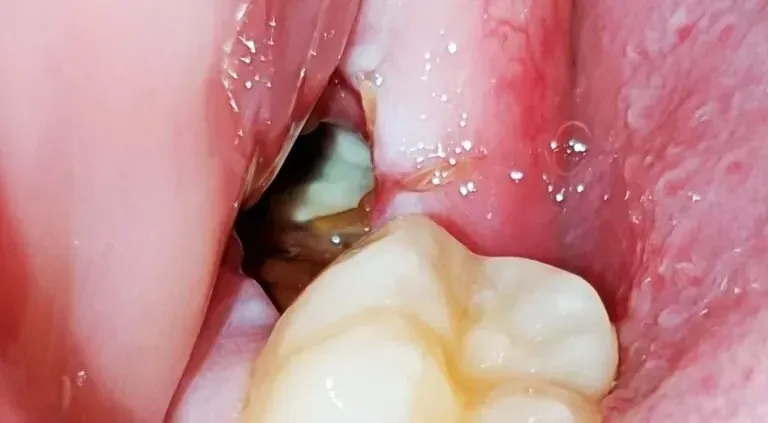Gum Swelling 2 Weeks After Tooth Extraction: Causes, Treatment & When to Worry (2026 Guide)
Experiencing gum swelling 2 weeks after tooth extraction can be concerning, and while some swelling is…
Experiencing gum swelling 2 weeks after tooth extraction can be concerning, and while some swelling is normal during the healing process, persistent or worsening inflammation at this stage may indicate an underlying issue. An infection, dry socket, or other complications could be the cause. If you’re noticing symptoms like severe pain, pus drainage, or fever alongside the swelling, it’s essential to contact your dentist right away. They can determine the root cause and provide the appropriate treatment to resolve the issue safely and effectively.
In this comprehensive 2026 guide, we’ll walk you through everything you need to know about prolonged gum swelling after tooth extraction, including what’s normal, what’s not, and how to promote faster, healthier healing.
Is Gum Swelling Normal 2 Weeks After Tooth Extraction?
Swelling of the gums is a common and expected part of the healing process following a tooth extraction. Typically, swelling peaks around 48 to 72 hours post-procedure and then gradually subsides over the next week. However, if the swelling persists or worsens two weeks after the extraction, it could signal a complication that requires professional attention.
While mild residual swelling can sometimes linger, especially after complex extractions like wisdom teeth removal, significant inflammation at the two-week mark is not typical. Other symptoms that may accompany abnormal swelling include:
- Severe or throbbing pain that doesn’t improve with medication
- Pus or discharge from the extraction site
- Fever or chills
- Foul taste or odor in the mouth
- Difficulty opening your mouth or swallowing
If you’re experiencing any of these signs, contact your dentist immediately. They will evaluate the extraction site, identify the cause of the swelling, and recommend the appropriate treatment to prevent further complications.
Why it helps: Gently cleanses extraction sites and reduces inflammation without harsh chemicals, promoting natural healing.
Common Causes of Gum Swelling 2 Weeks After Tooth Extraction
Several factors can contribute to prolonged gum swelling after a tooth extraction. Understanding these causes can help you identify the problem and seek timely treatment.
1. Infection (Alveolar Osteitis or Abscess)
One of the most common reasons for persistent swelling is an infection at the extraction site. This can occur if bacteria enter the socket, especially if the blood clot falls out prematurely or if proper oral hygiene isn’t maintained. Signs of infection include pus, severe pain, fever, and a bad taste in your mouth.
2. Dry Socket
Dry socket (alveolar osteitis) happens when the protective blood clot at the extraction site becomes dislodged or dissolves too early, exposing the underlying bone and nerves. This condition typically causes intense pain around days 3 to 5, but lingering inflammation and discomfort can persist for weeks if untreated.
3. Retained Bone Fragments
Sometimes, small pieces of bone or tooth fragments remain in the gum after extraction. These can irritate the surrounding tissue, leading to prolonged swelling and discomfort.
4. Allergic Reaction or Sensitivity
In rare cases, patients may have an allergic reaction to medications, sutures, or materials used during the procedure, causing ongoing inflammation.
5. Poor Oral Hygiene
Failing to keep the extraction site clean can lead to bacterial buildup, delaying healing and causing swelling. It’s crucial to follow your dentist’s post-operative care instructions carefully.
Gum Swelling 2 Weeks After Wisdom Tooth Extraction
Wisdom tooth extractions are often more complex than standard tooth removals, especially if the teeth are impacted or require surgical intervention. As a result, the healing timeline can be longer, and some swelling may persist beyond the typical one-week mark. However, significant swelling at two weeks post-extraction should still be evaluated by your dentist.
If you’re dealing with throbbing pain after wisdom tooth extraction along with swelling, it’s especially important to rule out infection or dry socket. Your dentist may prescribe antibiotics, perform a gentle cleaning of the site, or recommend additional treatments to support healing.
How Long Does Gum Swelling Last After Tooth Extraction?
The duration of gum swelling varies depending on the complexity of the extraction and individual healing factors. Here’s a general timeline:
- Days 1-3: Swelling peaks and is most noticeable. Mild bleeding and discomfort are normal.
- Days 4-7: Swelling begins to subside. Pain should be manageable with over-the-counter medication.
- Weeks 2-3: Most swelling should be gone. The extraction site continues to heal internally.
- Beyond 3 weeks: Complete healing of the gum tissue and bone. Any residual swelling at this stage warrants a dental visit.
If you’re still experiencing noticeable swelling two weeks after your procedure, it’s time to consult your dentist to ensure everything is healing properly.
Why it helps: Provides targeted cold therapy to reduce swelling and numb discomfort around the extraction area.
How to Tell If Your Gum Is Infected After Tooth Extraction
Recognizing the signs of infection early can prevent serious complications. Here are the key symptoms to watch for:
- Severe, persistent pain: Pain that worsens or doesn’t improve with medication
- Swelling that increases: Rather than decreasing over time
- Pus or discharge: Yellow or white fluid oozing from the extraction site
- Fever: A body temperature above 100.4°F (38°C)
- Bad breath or taste: Foul odor or unpleasant taste that doesn’t go away with rinsing
- Red, inflamed gums: Especially around the extraction area
If you notice any of these signs, contact your dentist immediately. They may prescribe antibiotics, clean the site, or perform additional procedures to address the infection. For more information on managing post-extraction complications, check out our guide on what a healing tooth extraction should look like.
Treatment Options for Prolonged Gum Swelling
Treatment for gum swelling two weeks after extraction depends on the underlying cause. Your dentist may recommend one or more of the following:
Antibiotics
If an infection is present, your dentist will likely prescribe a course of antibiotics to eliminate the bacteria and reduce inflammation.
Cleaning and Debridement
Your dentist may gently clean the extraction site to remove debris, food particles, or infected tissue that could be prolonging the swelling.
Medicated Dressings
For dry socket or persistent inflammation, medicated dressings can be placed in the socket to promote healing and reduce pain.
Pain Management
Over-the-counter pain relievers like ibuprofen or acetaminophen can help manage discomfort. Your dentist may also prescribe stronger medication if needed.
Follow-Up Surgery
In rare cases, a follow-up surgical procedure may be necessary to remove bone fragments or address other complications.
Home Care Tips to Reduce Swelling and Promote Healing
While professional treatment is essential for complications, you can support your recovery at home with these tips:
- Apply cold compresses: Use ice packs on the outside of your face for 15-20 minutes at a time during the first 48 hours to minimize swelling.
- Rinse with salt water: Gently rinse your mouth with warm salt water (1/2 teaspoon salt in 8 oz water) 2-3 times daily to keep the area clean.
- Take prescribed medications: Follow your dentist’s instructions for antibiotics and pain relievers.
- Avoid irritating the site: Don’t smoke, use straws, or touch the extraction area with your tongue or fingers.
- Eat soft foods: Stick to a soft diet and avoid hot, spicy, or crunchy foods that could irritate the gums.
- Stay hydrated: Drink plenty of water to support overall healing.
- Elevate your head: Sleep with your head elevated to reduce swelling.
Why it helps: Ultra-soft bristles allow gentle cleaning around sensitive extraction sites without causing irritation or disrupting healing.
When to Contact Your Dentist
You should reach out to your dentist if you experience any of the following:
- Swelling that persists or worsens after two weeks
- Severe pain that doesn’t respond to medication
- Signs of infection (pus, fever, bad taste)
- Heavy bleeding that doesn’t stop
- Difficulty breathing or swallowing
- Any other unusual symptoms or concerns
Prompt attention can prevent complications and ensure a smooth, complete recovery.
Preventing Complications After Tooth Extraction
The best way to avoid prolonged swelling and other issues is to follow your dentist’s post-operative care instructions carefully. Here are some key prevention tips:
- Bite on gauze: Apply gentle pressure for 30-45 minutes immediately after extraction to help form a blood clot.
- Avoid smoking and alcohol: Both can interfere with healing and increase infection risk.
- Don’t rinse or spit vigorously: This can dislodge the blood clot and lead to dry socket.
- Follow dietary restrictions: Stick to soft, cool foods for the first few days.
- Maintain oral hygiene: Gently brush your teeth, avoiding the extraction site, and rinse as directed.
- Attend follow-up appointments: Your dentist will monitor your healing and address any concerns early.
Final Thoughts: Don’t Ignore Prolonged Swelling
Gum swelling 2 weeks after tooth extraction is not something to ignore. While some residual inflammation can be normal, especially after complex procedures, significant or worsening swelling often signals a complication that requires professional care. By staying vigilant, following your dentist’s instructions, and seeking help when needed, you can ensure a safe, smooth recovery and get back to your normal routine with confidence.
If you’re dealing with ongoing discomfort or have questions about your healing process, don’t hesitate to reach out to your dental care provider. Your oral health is too important to leave to chance, and timely intervention can make all the difference in your recovery journey.







